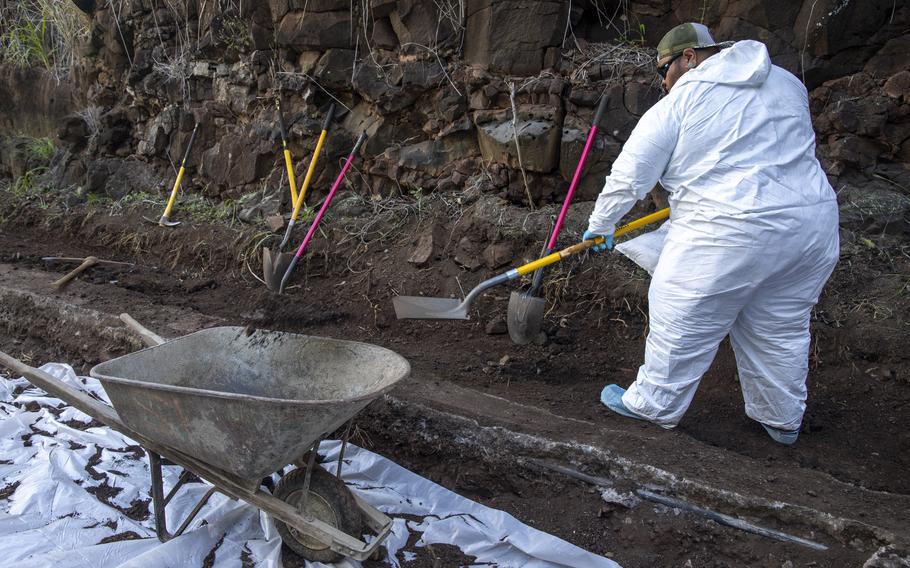
A Navy worker shovels contaminated soil into a wheelbarrow as part of a hazardous material spill recovery operation at the Red Hill fuel storage facility, Hawaii, Dec. 1, 2022. (Matthew Mackintosh/U.S. Army)
(Tribune News Service) — The military says it's pushed the deadline to the end of this week for an officer to complete his investigation into what caused an estimated 1,300 gallons of toxic fire suppressant to spill from a pipe at Red Hill on Nov. 29, though it won't say when that report might be released to the public.
The investigation was expected to be finished within 30 days, in accordance with Navy regulations, but a military spokesperson said the deadline has been extended after the investigating officer requested additional time to "ensure thoroughness and accuracy on this complicated matter."
Vice Adm. John Wade, commander of Joint Task Force-Red Hill, announced days after the spill of concentrated aqueous film forming foam, or AFFF, which is used to suppress fuel fires, that he had tapped Maj. Gen. Richard J. Heitkamp of the U.S. Army Reserve to investigate the cause of the incident as well as assess any fault or liability.
"Once the investigation into the cause of the release is finalized, it will be provided to JTF-RH leadership for endorsement and potential recommended action," U.S. Air Force Capt. Kitsana Dounglomchan, a spokesperson for the task force, said last week by email. "Depending on the nature of any JTF-RH recommendations, actions may be taken by other DoD entities which would then complete the investigation."
The report, as well as video footage of the spill, is expected to then be released publicly, but the Navy declined to provide an estimate on how long that might take. In the past it's been months before the Navy has released investigative findings related to accidents at Red Hill.
The AFFF spill ignited another round of criticism toward Navy officials overseeing the beleaguered Red Hill facility, where the Navy for 80 years has stored millions of gallons of fuel in massive underground tanks just 100 feet above the aquifer. The Navy is shutting down the aged facility after fuel from a spill in November 2021 seeped into its Joint Base Pearl Harbor-Hickam drinking water system, sickening military families.
At the time of the AFFF spill, a Navy contractor, Kinetix, was doing work on Red Hill's fire suppression system, according to the Navy. That system has been fraught with problems for years and was cited as a major factor in the 2021 water contamination crisis. A company hired by the Navy in 2022 to assess the facility found that the AFFF system needed to undergo significant repairs before 104 million gallons of fuel could be drained from the facility's tanks through underground pipelines.
Attempts by the Honolulu Star-Advertiser over the past week to reach officials with Kinetix who could discuss Red Hill were unsuccessful.
AFFF contains per-and polyfluoroalkyl substances, colloquially referred to as "forever chemicals" because they degrade so slowly in the environment. Chronic exposure to the chemicals has been linked to cancer and other health problems, prompting the U.S. Environmental Protection Agency in 2022 to tighten restrictions on the chemicals.
In the days following the spill, the Navy said dozens of workers were employed at the site near a tunnel entrance, removing asphalt and concrete, digging up soil and sopping up fluid with absorbent pads. In an attempt to contain the contamination, which entered the ground, workers dug up soil, storing it in more than 130 55-gallon drums. The Navy says it tested the soil to see how far down the AFFF might have leached into the ground.
But the Navy then paved over the ground before it received the test results, angering the Hawaii Sierra Club.
The Navy and the state Department of Health, which regulates the facility, called it a "temporary paving, " in response to questions from the Star-Advertiser.
"Initially, DOH approved the excavated site to be covered with plastic," said DOH spokesman Brooks Baehr by email. "However, heavy rains were forecasted so DOH approved the temporary paving of the road to prevent potential contamination from spreading. This action further reduces risk to public health and the environment. DOH and the Navy have agreed the paving is temporary."
The Navy said that if the results from soil samples indicate further excavation is required, then the pavement will be removed.
A Navy spokesman said the material used for resurfacing was asphalt, which is easier to remove than concrete, and that it could be removed within a couple of days if needed.
David Henkin, an attorney with Honolulu's Earthjustice, an environmental law firm that has represented the Hawaii Sierra Club in issues relating to Red Hill, called the public's trust in the military "irrevocably broken" and urged federal and state regulators to take the lead in investigating the AFFF spill.
"We have been told too many times by the military that everything is safe and under control, only to learn that, once again, the military has threatened our primary supply of life-giving water with poisons that could be with us for generations," he said by email. "The State Department of Health and the U.S. Environmental Protection Agency — not the military — need to be in charge of this investigation. Enough of the fox guarding the hen house."
(c)2023 The Honolulu Star-Advertiser
Visit The Honolulu Star-Advertiser at www.staradvertiser.com
Distributed by Tribune Content Agency, LLC.